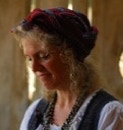Singer, Hammered Dulcimer Player, Storyteller
While Shepherd’s Watched 2:56
The Wren / Planxty George Brabazon 3:40
This song, the only surviving piece from The Pageant of the Shearmen and the Tailors, is medieval musical theater. This part of the story, known as the Massacre of the Innocents, concerns itself with the scene in which Herod sought to kill the Christ Child. Herod had been duped and “was in a furious rage, and he sent and killed all the male children in Bethlehem and in all that region who were two years old or under” (Matthew 2:16). The song comes to us from Coventry, England, circa the early 1500s.
Olde Christmas
Buy this Album on iTunes
Veni, Emmanuel / What Child is This 8:32
O Come, Emmanuel is based on the O Antiphons which come to us from the monasteries of the 8th
century. I chose to segue into What Child is This because the two songs theologically complete each
other: the call for Christ and the arrival of Christ. How powerful to think that this and similar prayers
have been lifted up for well over a thousand years.
Gloucestershire Wassail 2:33
Christmas would not be the same without hot cider and carols! The tradition of sharing hot cider on Christmas is said to come from 449AD when the Irish heroine Rowen offered a wassail cup to the king of Britain, and the king was so charmed that he married her. “Waes hael” means “be ye healthy”, so next time you toast the season, you can say “cheers!” or “salut!” or “wassail!”
O’Carolan’s Receipt
1:49
The story goes that Turlough O’Carolan was ordered by his doctor to stop drinking. This dreadful mandate sent the great artist into a deep blue musical funk, resulting in O’Carolan being unable to compose. Dr. John Strafford found O’Carolan wasting away so he prescribed a new receipt (or recipe) for the restoration of spirit and artistic creativity: a large whiskey. Tradition holds that O’Carolan promptly filled the receipt and wrote this joyful tune.
Child in the Manger 4:08
Some 200 years ago, on the distant northwest island of Mull in Gaelic speaking Scotland, Mary MacDonald tooka gorgeous traditional tune (called Bunessan) and added Christmas lyrics. Many years later Cat Stevens introduced Bunessan to every US household and church using Eleanor Farjeon’s poignant poem, “morning has broken...”
Coventry Carol 4:14
God Rest Ye Merry, Gentlemen 5:03
The opening line of this song extends a Christmas
wish for God to keep you strong (God rest ye merry) and healthy into the new year. This carol was first printed
in the 1780s in the popular songbook New Carols for Christmas. This rendition incorporates some fun modern harmonies. Song trivia: Charles Dickens moved the comma in 1843, changing the opening line to “God rest you, merry gentlemen,” expressing an entirely different sentiment and proving that punctuation matters.
This carol, also known as Please to See the King, may refer to the ancient rite of sacrificing the king (the wren being the king of all birds) so that the new sun could be born on the day after winter solstice. Later it was said that when Saint Stephen was hiding in a bush from those who would kill him, the wren betrayed his hiding place. Therefore, the wren was hunted “through hedges and stiles” to be sacrificed at Christmastime.
Good King Wenceslaus 4:04
The uplifting story of Saint Wenceslaus and his loyal servant Podevin inspires kindness. Saint Wenceslaus was actually only a Duke, but his righteousness caused Holy Roman Emperor Otto I to posthumously elevate him from Duke to King. The Angels We Have Heard On High chorus is peppered into this song because I know angels must have been there, celebrating the good Saint’s miracle.
A Virgin Unspotted 4:13
O’Carolan’s Fanny Power 2:20
In 1850 British essayist Walter Pater wrote, “All art constantlyaspirestowardstheconditionofmusic.” He was thinking of transcendent music, like the compositions of the blind Irish harper, Turlough O’Carolan (b. 1670), and this planxty, written for patroness Fanny Power.
George Frideric Handel. Need I say more? I sing this in honor of the brilliant tenor, generous teacher, and winsome man, Seth McCoy. May he rest in peace.
Silent Night (Stille Nacht) 3:36
One cold December night in Oberndorf, Austria, Father Josef Mohr took a poem he had written over to his friend Franz Xaver Gruber and requested Franz use the poem to compose a simple melody for the upcoming Christmas Eve service. On Christmas Eve, 1818, the two men sang the new composition with only a single guitar for accompaniment. Silent Night has now been translated into some 140 languages; it is truly an international song of peace, hope, and love.
Joy to the World 3:01
This Christmas hymn, published by Isaac Watts in 1719, has ended every Christmas service I have ever attended. The music clearly owes it’s origins to Handel, which is why we joyfully hum it for days and days after we hear it played. This is the only place in the album with recording ‘magic’ through which you will hear four hammers striking the dulcimer. I played the descending lines and then overdubbed another set of descending lines to create the illusion of bells.
This is both a Christmas carol and a political cautionary tale from 1661. Charles I clearly did not recognize that God himself came “to teach us humility” by being born in a manger. As a result, he lost both his power and his head. Oliver Cromwell and Parliament rose to power, but after Cromwell died the English invited Charles II to take the throne. Charles II needed to learn “haughty pride for to shun” if he wanted to rule alongside Parliament and avoid his father’s fate.
© Kathleen Johnson 2012-2016

